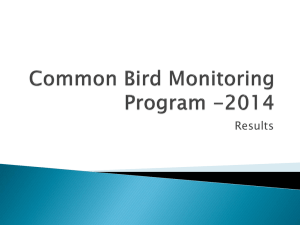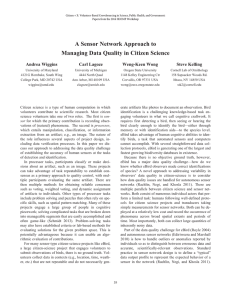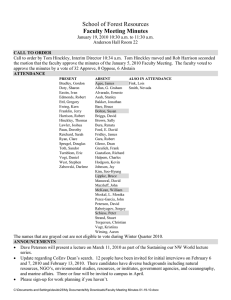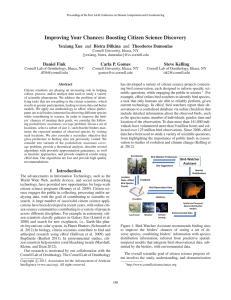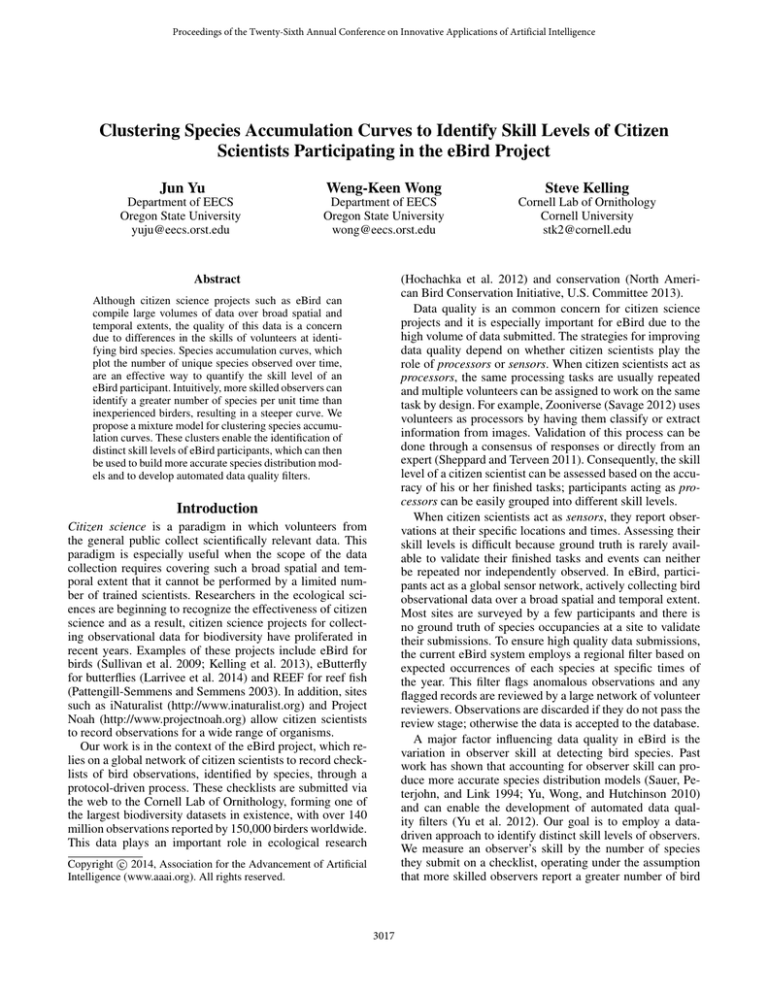
Proceedings of the Twenty-Sixth Annual Conference on Innovative Applications of Artificial Intelligence
Clustering Species Accumulation Curves to Identify Skill Levels of Citizen
Scientists Participating in the eBird Project
Jun Yu
Weng-Keen Wong
Steve Kelling
Department of EECS
Oregon State University
yuju@eecs.orst.edu
Department of EECS
Oregon State University
wong@eecs.orst.edu
Cornell Lab of Ornithology
Cornell University
stk2@cornell.edu
Abstract
(Hochachka et al. 2012) and conservation (North American Bird Conservation Initiative, U.S. Committee 2013).
Data quality is an common concern for citizen science
projects and it is especially important for eBird due to the
high volume of data submitted. The strategies for improving
data quality depend on whether citizen scientists play the
role of processors or sensors. When citizen scientists act as
processors, the same processing tasks are usually repeated
and multiple volunteers can be assigned to work on the same
task by design. For example, Zooniverse (Savage 2012) uses
volunteers as processors by having them classify or extract
information from images. Validation of this process can be
done through a consensus of responses or directly from an
expert (Sheppard and Terveen 2011). Consequently, the skill
level of a citizen scientist can be assessed based on the accuracy of his or her finished tasks; participants acting as processors can be easily grouped into different skill levels.
When citizen scientists act as sensors, they report observations at their specific locations and times. Assessing their
skill levels is difficult because ground truth is rarely available to validate their finished tasks and events can neither
be repeated nor independently observed. In eBird, participants act as a global sensor network, actively collecting bird
observational data over a broad spatial and temporal extent.
Most sites are surveyed by a few participants and there is
no ground truth of species occupancies at a site to validate
their submissions. To ensure high quality data submissions,
the current eBird system employs a regional filter based on
expected occurrences of each species at specific times of
the year. This filter flags anomalous observations and any
flagged records are reviewed by a large network of volunteer
reviewers. Observations are discarded if they do not pass the
review stage; otherwise the data is accepted to the database.
A major factor influencing data quality in eBird is the
variation in observer skill at detecting bird species. Past
work has shown that accounting for observer skill can produce more accurate species distribution models (Sauer, Peterjohn, and Link 1994; Yu, Wong, and Hutchinson 2010)
and can enable the development of automated data quality filters (Yu et al. 2012). Our goal is to employ a datadriven approach to identify distinct skill levels of observers.
We measure an observer’s skill by the number of species
they submit on a checklist, operating under the assumption
that more skilled observers report a greater number of bird
Although citizen science projects such as eBird can
compile large volumes of data over broad spatial and
temporal extents, the quality of this data is a concern
due to differences in the skills of volunteers at identifying bird species. Species accumulation curves, which
plot the number of unique species observed over time,
are an effective way to quantify the skill level of an
eBird participant. Intuitively, more skilled observers can
identify a greater number of species per unit time than
inexperienced birders, resulting in a steeper curve. We
propose a mixture model for clustering species accumulation curves. These clusters enable the identification of
distinct skill levels of eBird participants, which can then
be used to build more accurate species distribution models and to develop automated data quality filters.
Introduction
Citizen science is a paradigm in which volunteers from
the general public collect scientifically relevant data. This
paradigm is especially useful when the scope of the data
collection requires covering such a broad spatial and temporal extent that it cannot be performed by a limited number of trained scientists. Researchers in the ecological sciences are beginning to recognize the effectiveness of citizen
science and as a result, citizen science projects for collecting observational data for biodiversity have proliferated in
recent years. Examples of these projects include eBird for
birds (Sullivan et al. 2009; Kelling et al. 2013), eButterfly
for butterflies (Larrivee et al. 2014) and REEF for reef fish
(Pattengill-Semmens and Semmens 2003). In addition, sites
such as iNaturalist (http://www.inaturalist.org) and Project
Noah (http://www.projectnoah.org) allow citizen scientists
to record observations for a wide range of organisms.
Our work is in the context of the eBird project, which relies on a global network of citizen scientists to record checklists of bird observations, identified by species, through a
protocol-driven process. These checklists are submitted via
the web to the Cornell Lab of Ornithology, forming one of
the largest biodiversity datasets in existence, with over 140
million observations reported by 150,000 birders worldwide.
This data plays an important role in ecological research
c 2014, Association for the Advancement of Artificial
Copyright Intelligence (www.aaai.org). All rights reserved.
3017
species per unit of time. We propose to represent a participant’s skill level using a Species Accumulation Curve
(SAC) (Gotelli and Colwell 2001), which plots the cumulative number of unique species observed as a function of
the cumulative effort expended (e.g. time). SACs are typically used in the ecological literature to quantify species
richness (Chao and Jost 2012). However, we repurpose the
use of SACs as a measure of an observer’s skill at detecting species. We can compare the skills of participants using
their SACs if we can control for the environment in which
they make their observations. Intuitively, skilled birders rely
on both sound and sight to identify bird species. Thus, they
are able to identify more species per unit time than inexperienced birders in the same environment, resulting in a steeper
SAC.
We can then cluster participant SACs to identify distinct
skill levels of birders in the data. To accomplish this task, we
develop a mixture model to cluster the SACs of eBird participants and derive a learning algorithm based on ExpectationMaximization. In our experiments, we apply our model to
eBird data and show that the resulting clusters are meaningful and correspond to distinct skill levels.
we found that the square root model produced the best fit to
the data, where the fit is measured in terms of mean squared
error on a holdout set.
The structure of the mixture model corresponds to the following generative process. For each birder i, we first generate its group membership Zi by drawing from a multinomial distribution with parameter π. Next, birder i produces
Ni checklists. On each checklist j, the expected number of
species detected is β Zi · Xij where β Zi are the parameters
of group Zi . Finally, the number of species actually reported
(Yit ) is generated by drawing from a Gaussian distribution
with mean β Zi ·Xij and variance σ 2 . Here we assume SACs
in different groups share the same variance σ 2 . The loglikelihood for this mixture model is given in the following
equation.
M
X
log
i=1
K
X
P (Zi = k; π)
Ni
Y
!
P (Yij |Xij , Zi = k; β, σ 2 )
j=1
k=1
Parameter estimation
During learning, we estimate the model parameters
{π, β, σ 2 } and the latent group membership Z for each
birder using Expectation Maximization (EM) (Dempster,
Laird, and Rubin 1977). The EM algorithm iterates between
performing the E-step and M-step until convergence. In the
E-step, EM computes the expected group membership for
every birder i. In the M-step, we re-estimate the model parameters {π, β, σ 2 } that maximize the expected complete
log-likelihood in the equation below. In addition, let rik denote the expected group membership of birder i belonging
to group k.
The mixture of SACs model
In the mixture of SACs model, we assume that there is a
fixed number K of distinct groups of observers and observers in the same group are at a similar skill level. As eBird
is our application domain, we use observer and birder interchangeably. Figure 1 shows a plate diagram of the mixture of SACs model. The plate on the left represents K
groups where group k is parameterized with β k . The outer
plate on the right represents M birders. The variable Zi ∈
{1, · · · , K} denotes the group membership of birder i. The
inner plate represents Ni checklists submitted by birder i.
The variable Xij represents the amount of effort (e.g. duration) and Yij specifies the number of unique species reported
on checklist j of birder i. Finally, let Xij denote the vector
consisting of the variable Xij and the intercept term.
Q = EZ|Y ,X [log(P (Y , Z|X; π, β, σ 2 ))]
=
M X
K
X
EZ|Y ,X [I(Zi = k)]
i=1 k=1
log P (Zi = k; π)
Ni
Y
2
P (Yij |Xij , Zi = k; β, σ )
j=1
(1)
In the E-step, we keep the parameters {π, β, σ 2 } fixed
and update the expected group membership rik for every
birder i and group k. This expected membership can be computed as the posterior probability in the equation below.
rik
Figure 1: The mixture of Species Accumulation Curves
model.
= P (Zi = k|Xi· , Yi· ; π, β, σ 2 )
Q i
2
P (Zi = k; π) N
j=1 P (Yij |Xij , Zi = k; β, σ )
= PK
Q
N
i
0
0
2
k0 =1 P (Zi = k ; π)
j=1 P (Yij |Xij , Zi = k ; β, σ )
The observation variable Yij depends on the effort Xij
and the skill level of birder i, indicated by the group membership Zi . To model their relationship in a SAC, we use
a linear regression model with
p a square root transformation
on Xij (i.e. Yij = β0 + β1 Xij ). A number of alternative
models could be used (eg. negative binomial regression) but
In the M-step, we re-estimate {π, β, σ 2 } using the expected membership computed in the E-step. To estimate πk ,
we introduce a Lagrange multiplier λ to ensure that the conPK
PM
straint k=1 πk = 1 is satisfied. i.e. i=1 rik − λπk = 0.
Summing
over all k ∈ {1, · · · , K}, we find that λ =
P P
r
= M . Thus we plug λ into the equation above
ik
i
k
3018
and get the updating equation for πk .
number of birders, we can not validate the clusters by manually verifying each birder’s submissions. Instead, we propose to validate the clusters based on an individual birder’s
ability to identify hard-to-detect species and use anecdotal
information from the eBird project staff. We also run the
same analyses on eBird hotspots where the number of observers is relatively small, allowing us to manually verify
their skills and validate the clustering results.
M
1 X
πk =
rik
M i=1
To estimate β k , we compute the gradient of β k w.r.t. the
expected complete log-likelihood Q in Equation 1. Notice
that the gradient of β k has the same form as that of a linear
regression model, except each instance is associated with a
weight of rik . Thus we can use the method of least squares
to update β k efficiently.
Grouping eBird participants
First, we remove the birders who submitted fewer than 20
checklists because their data is too sparse to fit a SAC. Then,
we limit our analysis to only include checklists with duration less than 2 hours. To find the number of distinct groups
in the data, we split the data into training and validation sets.
We train the mixture model on the training set with different
values of K ∈ {1, · · · , 5}, and then we calculate the average log-likelihood on the validation set. The best value of
K is chosen when increasing K does not improve the average log-likelihood. In Table 1, we show the average loglikelihood on the holdout data in four states. The graphs
clearly show that there are 3 distinct groups in all four states.
Ni
M
X
∂Q
1 X
= 2
rik
(Yij − β k Xij )Xij
∂β k
σ i=1
j=1
Finally, we compute the gradient of σ 2 w.r.t. the expected
complete log-likelihood Q and the updating equation for the
parameter σ 2 has the closed-form solution.
PM PK
PNi
2
j=1 (Yij − β k Xij )
i=1
k=1 rik
2
σ =
PM
i=1 Ni
Since the EM algorithm may converge to a local maximum of the expected complete log-likelihood function, depending on initialization of the parameters, we use random
restart by assigning each birder to a group randomly. The
expected membership ri· specifies a soft clustering of birder
i. To partition birders in the training data, we assign each
birder to the group with the largest expected membership.
State
NY
FL
TX
CA
To determine the number of groups in the data, we start
the mixture model with only one group (K=1) and gradually increase the value of K until it does not improve
the average log-likelihood on a holdout set. The average
log-likelihood is defined in the following equation. Unlike the log-likelihood function, we compute the data likelihood of a birder by averaging the observation probability
P (Yij |Xij , Zi = k; β, σ 2 ) over all the observations from
that birder.
i=1
log
K
X
k=1
PNi
P (Zi = k; π)
j=1
P (Yij |Xij , Zi = k; β, σ 2 )
K=2
-3.407
-3.389
-3.496
-3.483
K=3
-3.396
-3.387
-3.491
-3.481
K=4
-3.400
-3.393
-3.495
-3.489
K=5
-3.406
-3.405
-3.501
-3.493
Table 1: The average log-likelihood of the holdout data in
four states. The numbers in bold indicate the number of distinct groups found in that state.
Determining the number of groups
M
X
K=1
-3.456
-3.398
-3.543
-3.507
State
NY
FL
TX
CA
!
Ni
The percent of birders
G1
G2
G3
7%
37%
56%
19%
45%
36%
18%
44%
38%
12%
40%
48%
Avg CLs per birder
G1
G2
G3
407
215
152
200
125
124
132
157
99
236
195
111
Table 2: The percent of birders and the average number of
checklists submitted per birder in each group (G1-G3) in the
four states.
Evaluation and Discussion
Given the value of K chosen above, we re-estimate the
mixture model using all the data in 2012 and show the SACs
of different groups in four states in Figure 2. We sort the
SACs by their slope coefficient β1 in decreasing order so
that the first group corresponds to the most skilled observers
and the last group corresponds to the least skilled observers.
The red curve corresponding to the top group has a consistently higher SAC than the other two groups across all four
states. Birders in this top group are able to detect around
40 unique species during a 2-hour birding trip, while birders in group 2 and group 3 can only detect around 30 and
20 species. Though the number of distinct groups are the
same in all four states, the proportions of groups are very
We evaluate the mixture of SACs model using the eBird Reference Data (Munson et al. 2009) from 2012. We perform
four separate studies using four species-rich states that have
high levels of year-round eBird participation (New York,
Florida, Texas, and California). We attempt to control for
species richness in the environment by using state boundaries; in future work, we will look at using Bird Conservation Regions, which are more homogenous with regard to
species richness than political boundaries. We evaluate the
mixture model’s ability to accurately cluster eBird participants into groups based on their skill levels. However, evaluating the clustering results is challenging due to the lack of
ground truth on the participants’ skill levels. Given the large
3019
Figure 2: The SACs learned from the mixture of SACs model in four states. The proportion of birders in each group is indicated
in parentheses. The shaded area of a curve shows the 95% confidence interval containing the mean of the curve.
different. In New York and California, there are 7% and 12%
participants falling into the top group as they are able to detect more species per unit of time. In Florida and Texas, the
size of the top group is bigger, with 19% and 18% observers
respectively. One explanation is that in New York, a small
group of observers from the Cornell Lab of Ornithology are
extremely skilled at identifying bird species and this elite
skill level distinguishes them from the rest of the eBird participants in New York.
In Table 2, we report the proportion of observers and the
average number of checklists submitted per birder in each
group. The observers in the more skilled groups submit more
checklists than observers in the less skilled groups. This
matches our intuition that observers who are more active and
involved in the eBird project tend to be more skilled at detecting bird species. To demonstrate the differences in birding skills of birders across groups, we randomly choose two
birders from each group in New York and show their SACs
in Figure 3. Birders in the top group are able to accumulate
species much faster especially in the first 30-45 minutes than
birders in groups 2 and 3.
(a) Group 1
(b) Group 2
(c) Group 3
Figure 3: The SACs of six eBird participants from New
York, with two participants from each of the three groups.
Each point represents a checklist submitted by the birder.
The darkness of a point in the scatterplot specifies the number of checklists overlapped in the location. A darker color
indicates more checklists overlapped at that point.
Detection of hard-to-detect bird species
A good partition of birders leads to distinct differences in
the skill levels of different groups. Since we do not have
ground truth on birders’ skills, we characterize their skill
levels in terms of their ability to detect hard-to-detect bird
species. Hard-to-detect species often require more experience and skills to be identified, e.g. some species can be detected by sound rather than by sight and some species can be
detected only if observers know their habitats. In our experiment, we use 8 hard-to-detect species in each state suggested
by experts at the Cornell Lab of Ornithology and calculate
the average detection rate of observers within each group.
An observer’s detection rate of a species is defined to be
the percent of one’s checklists that report the detection of
that species. In Figure 4, we show the average detection rate
of the hard-to-detect species in each group. The top group
has the highest detection rate across all species in all four
states, showing that a steeper SAC does in fact correspond
3020
of a user’s level of expertise. Despite the overarching theme
of modeling particpant expertise, there are fundamental differences between eBird and these domains in terms of the
structure of the data as well as the underlying processes that
generate the data. Furthermore, the indicators of expertise in
eBird are more subtle and less overt than the explicit user
ratings in question answering communities. Consequently,
custom models need to be developed for discovering skill
levels of eBird participants.
Yu et al. (2010) show that including the expertise of observers into a species distribution model can produce more
accurate predictions of species occurrence. Their work assumes that training data labeled with the skill levels of eBird
participants is available. Obtaining this training data is difficult and only possible on a limited scale. Our current work
provides a more viable alternative to obtaining this training
data by providing an unsupervised approach for identifying
distinct observer skill levels and assigning birders to these
skill levels.
to a better skill level. As we go from group 1 to group 3,
the detection rate of reporting these species keeps decreasing and shows statistically significant differences between
two adjacent groups. These differences show that birders in
different groups vary greatly in their skill levels and the mixture model is able to cluster birders of similar skills into the
same group.
In addition, we sent a list of birder IDs in the top group
for New York to the eBird project leaders and asked them
to verify if these birders are reputable birders in the community. Out of 30 birders in the top group, 25 are experts
from the Cornell Lab of Ornithology or known regional experts in New York while the other 5 observers are known
to be reputable birders submitting high quality checklists to
eBird. Thus, the mixture model is able to identify a group of
top eBird contributors that are highly skilled birders and distinguish their behavior from the other groups of eBird participants.
eBird Hotspots
Conclusion
Since validating the clusters of birders at each location in
a state is not viable, we run the same analysis on data from
two eBird hotspots (Stewart Park and Hammond Hill in New
York), where the smaller number of observers allows human verification of the skill levels of individual birders. The
eBird hotspots are public birding locations that are often
heavily visited all year around. After training the mixture
model using data submitted in these two hotspots, the model
discovers 2 groups in Stewart Park and only 1 group in Hammond Hill. The SACs of these two eBird hotspots are shown
in Figure 2. In Stewart Park, there are 25 birders submitting at least 10 checklists in 2012 and about half of the birders (13 birders) are classified into group 1. Members of the
eBird project assessed the skill levels of the birders by the
reputation of these birders in the local birding community
and by manually inspecting their submitted checklists. All
13 birders in group 1 have been verified to be expert birders
and 10 out of the other 12 birders have been verified to be
novice birders. There are two skilled birders classified into
group 2 because most of their submissions are short duration observations, making the curve fitting of their observations less accurate. In Hammond Hill, there are only 10
birders submitting at least 10 checklists in 2012 and all of
them have been manually verified to be expert birders by the
eBird project staff using the same process. Thus, the mixture model is able to find the correct number of groups and
cluster birders with similar skill levels into the same group.
We proposed a mixture model for SACs that was successful
at identifying well-defined skill levels of eBird participants.
In our experiments over four species-rich states, these clusters correspond to groups that distinctly vary in their ability
to observe hard-to-detect bird species. Furthermore, when
we applied the model to two birding hotspots in New York,
the model produced accurate and meaningful clusters as verified by domain experts on the eBird project staff.
The mixture of SACs model can be readily applied
to other citizen science projects that collect observational
species data (eg. eButterfly) and we plan to evaluate its effectiveness on such data. The applicability of our mixture
model to other citizen science or crowdsourcing projects depends on whether participant skill can be quantitatively described by a metric similar to a SAC. If such a metric exists
and can be reasonably represented as a linear model, then the
mixture model presented in our work can be easily modified
for that data.
For future work, we plan to extend the model by accounting for other covariates that affect the SACs, such as location and time of year. In addition, we intend to integrate the
mixture of SACs approach with the Occupancy-DetectionExpertise model in (Yu, Wong, and Hutchinson 2010). Finally, we would like to investigate the evolution of an observer’s skill level over time.
Acknowledgements
Related Work
The authors would like to thank Marshall Iliff, Brian Sullivan and Chris Wood for their bird expertise as well as Bistra
Dilkina, Jeff Gerbracht, Carl Lagoze and Andrea Wiggins
for their insight discussions. This material is based upon
work supported by the National Science Foundation under
Grants No. 0941748 and 1209714.
The topic of user expertise has been explored in other crowdsourcing projects. In question answering communities, researchers are interested in identifying authoritative users
by examining content ratings and user reputation (Bian et
al. 2009), participation characteristics of experts (Pal et al.
2011) and the link structure of the community (Jurczyk and
Agichtein 2007). In product recommendation, McAuley and
Leskovec (2013) present a latent-factor recommender system that uses online product reviews to learn the progression
3021
Figure 4: The average detection rate of three groups on 8 hard-to-detect species in NY, FL, TX and CA. The error bars represent
the standard error of detection rate within a group.
3022
References
Savage, N. 2012. Gaining wisdom from crowds. Commun.
ACM 55(3):13–15.
Sheppard, S. A., and Terveen, L. 2011. Quality is a verb: the
operationalization of data quality in a citizen science community. In Proceedings of the 7th International Symposium
on Wikis and Open Collaboration, 29–38.
Sullivan, B. L.; Wood, C. L.; Iliff, M. J.; Bonney, R.; Fink,
D.; and Kelling, S. 2009. ebird: A citizen based bird observation network in the biological sciences. Biological Conservation 142(10):2282–2292.
Yu, J.; Kelling, S.; Gerbracht, J.; and Wong, W.-K. 2012.
Automated data verification in a large-scale citizen science
project: a case study. In Proceedings of the 8th IEEE International Conference on E-Science, 1–8.
Yu, J.; Wong, W.-K.; and Hutchinson, R. 2010. Modeling experts and novices in citizen science data for species
distribution modeling. In Proceedings of the 2010 IEEE International Conference on Data Mining, 1157–1162.
Bian, J.; Liu, Y.; Zhou, D.; Agichtein, E.; and Zha, H. 2009.
Learning to recognize reliable users and content in social
media with coupled mutual reinforcement. In Proceedings
of the 18th International Conference on World Wide Web,
WWW ’09, 51–60. New York, NY, USA: ACM.
Chao, A., and Jost, L. 2012. Coverage-based rarefaction and
extrapolation: standardizing samples by completeness rather
than size. Ecology 93:2533–2547.
Dempster, A. P.; Laird, N. M.; and Rubin, D. B. 1977. Maximum likelihood from incomplete data via the em algorithm.
Journal of Royal Statistical Society 39(1):1–38.
Gotelli, N., and Colwell, R. 2001. Quantifying biodiversity:
procedures and pitfalls in the measurement and comparison
of species richness. Ecology Letters 379–391.
Hochachka, W.; Fink, D.; Hutchinson, R.; Sheldon, D.;
Wong, W.-K.; and Kelling, S. 2012. Data-intensive science
applied to broad-scale citizen science. Trends in Ecology
and Evolution 27(2):130–137.
Jurczyk, P., and Agichtein, E. 2007. Discovering authorities
in question answer communities by using link analysis. In
Proceedings of the Sixteenth ACM Conference on Conference on Information and Knowledge Management, CIKM
’07, 919–922. New York, NY, USA: ACM.
Kelling, S.; Lagoze, C.; Wong, W.-K.; Yu, J.; Damoulas, T.;
Gerbracht, J.; Fink, D.; and Gomes, C. P. 2013. ebird: A
human/computer learning network to improve conservation
and research. AI Magazine 34(1):10–20.
Larrivee, M.; Prudic, K. L.; McFarland, K.; and Kerr, J.
2014. ebutterfly: a citizen-based butterfly database in the
biological sciences. http://www.e-butterfly.org.
McAuley, J. J., and Leskovec, J. 2013. From amateurs
to connoisseurs: Modeling the evolution of user expertise
through online reviews. In Proceedings of the 22nd International Conference on World Wide Web, WWW ’13, 897–908.
Munson, M. A.; Webb, K.; Sheldon, D.; Fink, D.;
Hochachka, W. M.; Iliff, M.; Riedewald, M.; Sorokina, D.;
Sullivan, B.; Wood, C.; and Kelling, S. 2009. The ebird reference dataset, version 1.0. Cornell Lab of Ornithology and
National Audubon Society, Ithaca, NY.
North American Bird Conservation Initiative, U.S. Committee. 2013. The state of the birds 2013 report on private
lands.
Pal, A.; Farzan, R.; Konstan, J. A.; and Kraut, R. E. 2011.
Early detection of potential experts in question answering
communities. In Proceedings of the 19th International Conference on User Modeling, Adaption, and Personalization,
UMAP’11, 231–242. Berlin, Heidelberg: Springer-Verlag.
Pattengill-Semmens, C. V., and Semmens, B. X. 2003. Conservation and management applications of the reef volunteer fish monitoring program. Env. Monitor. Assess. Journal.
81:43–50.
Sauer, J. R.; Peterjohn, B. G.; and Link, W. A. 1994. Observer differences in the north american breeding bird survey. The Auk 111(1):50–62.
3023

